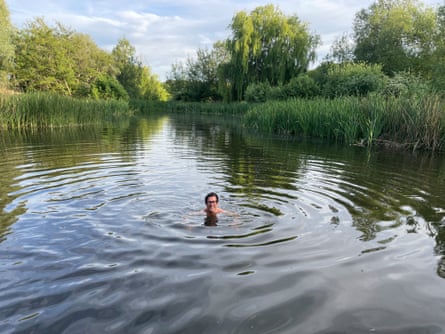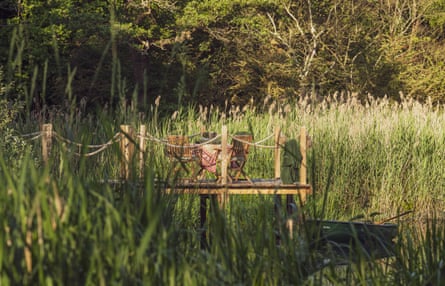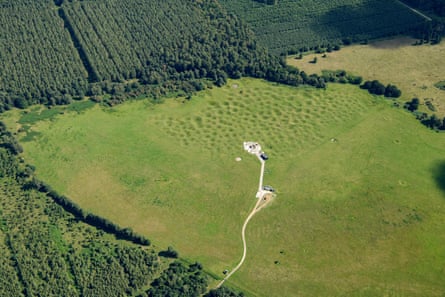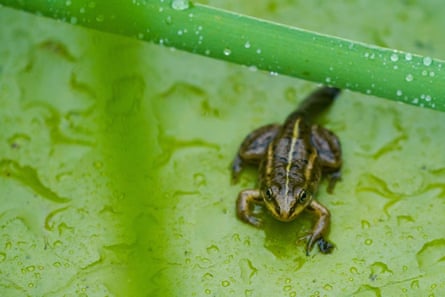The small white signs with red lettering are dotted through the landscape: “Military training area – keep out”. It adds to the eerie feel of unusually quiet roads and twisted Scots pines, which gather the long summer dusk around them.
But when we arrive at our accommodation on an old farm bordering a forbidden area where the British army conduct secretive manoeuvres, the whole place sings with peace. A red kite cavorts in the breeze over handsome parkland, a cuckoo calls and, down by the Wissey, a gin-clear chalk stream, reed warblers chunter from deep within the rushes.
If ever a region deserved to be its own county, it’s Breckland. This is a unique swath of south Norfolk and north Suffolk dominated by sandy heathland. It has an unusually dry climate more typical of central Europe and is notable for its rare plants and birds. Once an area dominated by inland sand dunes and commercial rabbit warrens, since the 20th century it’s been planted with the pines and conifers of Thetford forest. These woods offer a wealth of walks but there is also the vast Stanta army training area, 30,000 acres in size, where people cannot go – and other species thrive.
Breckland is a stronghold for charismatic endangered birds such as the goggle-eyed stone-curlew, dashing forest-dwelling goshawks and enigmatic, nocturnal nightjars. It’s home to ultra-rare and fantastically named plants and invertebrates, from the prostrate perennial knawel to the wormwood moonshiner beetle. It has every conservation designation going and would undoubtedly be a national park if so much of it hadn’t been commandeered by the military.
This land is usually overlooked by visitors whizzing through en route to the Norfolk coast or Norwich. It’s perhaps not helped by an absence of pretty towns and fancy restaurants (although well-heeled Bury St Edmunds on its southern edge boasts the Michelin-starred Pea Porridge). I live 30 miles away and I’ve never brought my family for a holiday here, until now.

My children immediately take to Bodney Hall Farm, where we are staying in a beautifully renovated cottage, the smaller of two high-end self-catering options. Guests are given the run of the 40-acre grounds and gardens which roll down to the River Wissey and feature a magical mix of interesting trees, formal planting, wildflowers and wildlife.
We stroll the banks of this private stretch of the Wissey. Since relocating from London in 2016, owners Henry and Anna Sands have been restoring the river, encouraging natural wiggles and bringing back the natural clarity of the water as it races over shingle, providing homes for dashing inhabitants including wild trout and kingfishers.
It’s possible to swim in the river but there’s also a jetty for easy access into a large Wissey-fed pond enveloped by rushes and willows. We savour a long evening swim to the soundtrack of cuckoos and reed warblers and – to my amazement – even a booming bittern. The water is sweet and fresh, and I feel as if we could be in Scandinavia, especially when we warm ourselves in our private woodfired hot tub as the first stars emerge. I’m hoping for a strange drone or red flare from the military training area, but all is quiet.

I rise early for a 5.45am swim and just miss an otter – Henry Sands, who is up even earlier, spots it – and there’s just enough time for a morning hot tub before we head to nearby Grime’s Graves, the largest known and best excavated flint mine in the country. Here, 4,500 years ago, late Neolithic people dug up to 1,000 mines up to 13 metres below ground and used antler picks to extract flints embedded in the chalk. The flint was particularly high quality and exported across the country, making specialist tools and weapons. The site is a large grassy clearing filled with the strange lumps and pits that are old, long-filled-in mineshafts. The air is filled with the song of dozens of skylarks.
The English Heritage visitor centre is pleasingly low-key – and quiet, naturally – with “please touch” signs so we can feel the weight of flints and the sharp edges of knapped stone. My kids enjoy brandishing replica axes before we move to the real highlight: descending into a nine-metre mineshaft excavated by archeologists in 1914. They found the remains of antler picks, pottery, animal bones and neolithic bats – and Daubenton’s bats still roost in the excavated shafts where it is a constant 8C.

“It smells nice down here,” says my son Ted as we descend the steel staircase. The scent is cool, damp stone. At the bottom, we can crawl on the chalk a short way into some of the horizontal excavations. It’s a vivid experience, a portal into another time.
Dark holes is a theme of our day because we next head to Oxburgh Hall, a stately home that has a priest’s hole which I remember from childhood was a thrilling portal into Tudor terror. On our way, we drop in on Foulden Common, one of a plethora of tranquil but rare wildlife-packed nature reserves including Weeting Heath and Lakenheath Fen. Thetford forest boasts several good country parks and there’s a multitude of cycle rides, swims (the Little Ouse is another gorgeous small river) and walks, including the long-distance Peddars Way on the old Roman road leading from Thetford to the north-west Norfolk coast.
Oxburgh is a red-brick Tudor palace surrounded by a fine moat which must be one of the most picturesque National Trust properties. The hall was built by Sir Edmund Bedingfeld around 1476 and the 10th baronet still lives in a wing of the house. The rest of his ancestral home is open to the public, and the rooms are filled with vast oil portraits, ornate furniture, ancient books and even leather wallpaper, which was amusingly purchased secondhand from Spain by thrifty Victorian aristocrats.
The priest’s hole was built up a tiny staircase, below a brick-topped iron hatch, so the Bedingfield family’s Catholic priest could be safely concealed during the persecution of the Catholics that saw the family fall from favour when they refused to renounce their faith. It is not known how much action the hole saw, but this tiny claustrophobic stone cell may have saved the life of a priest or three.
Unfortunately, after a visitor became stuck in the hole (it’s oddly much harder to get out than in) we’re no longer allowed inside, and have to make do with peering down the hatch and watching a video of a stressed (actor) priest fretting inside.

After a late lunch at the Bedingfeld Arms, with swifts screaming as they circle the 1783 pub, I take an evening excursion to another unique nature reserve: Thompson Common. The map reveals this to be another place of strange indentations in the land: a profusion of nearly 500 pingos, small ponds formed when subterranean mounds of ice thawed and the soil slumped down at the end of the last ice age. It’s a bewitchingly unusual place, home to rare dragonflies and the very rare pool frog, which became extinct in the 1990s but has been successfully reintroduced from Sweden. The males can be heard “singing” in late spring, via a pair of white inflatable sacs like airbags either side of their head.
There’s an eight-mile circular pingo walking trail for a full day out but I took a shorter potter through the reserve. The frogs are doing well thanks to restoration work by Norfolk Wildlife Trust which has seen the excavation and revival of a dozen “ghost” pingoes, with many ponds filled in during a century of agricultural “improvement” and intensification.
I’d like to say we enjoyed a fine evening of the frog chorus but there’s nothing melodic about the groaning croak which sounds like a duck with laryngitis. They don’t call on my visit; instead I hear the bugling song of a crane from somewhere in the undergrowth. It’s another notable experience in this fascinating land, which is much the finer for its all-enveloping strangeness.
Accommodation was provided by Bodney Hall Farm,which has a cottage (sleeps 4) from £300 a night and lodge (sleeps 12). Grimes Graves (English Heritage) is open daily 10am-5pm (family up to five from £20.70). Oxburgh Hall (National Trust) open 10.30am–3pm; gardens 9.30am–5pm (family up to five from £32.50). Foulden Common and Thompson Common (Norfolk Wildlife Trust) are free to enter

 8 hours ago
2
8 hours ago
2










 English (US)
English (US)